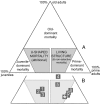Cooperative hunting and meat sharing 400-200 kya at Qesem Cave, Israel
- PMID: 19666542
- PMCID: PMC2726383
- DOI: 10.1073/pnas.0900564106
Cooperative hunting and meat sharing 400-200 kya at Qesem Cave, Israel
Abstract
Zooarchaeological research at Qesem Cave, Israel demonstrates that large-game hunting was a regular practice by the late Lower Paleolithic period. The 400- to 200,000-year-old fallow deer assemblages from this cave provide early examples of prime-age-focused ungulate hunting, a human predator-prey relationship that has persisted into recent times. The meat diet at Qesem centered on large game and was supplemented with tortoises. These hominins hunted cooperatively, and consumption of the highest quality parts of large prey was delayed until the food could be moved to the cave and processed with the aid of blade cutting tools and fire. Delayed consumption of high-quality body parts implies that the meat was shared with other members of the group. The types of cut marks on upper limb bones indicate simple flesh removal activities only. The Qesem cut marks are both more abundant and more randomly oriented than those observed in Middle and Upper Paleolithic cases in the Levant, suggesting that more (skilled and unskilled) individuals were directly involved in cutting meat from the bones at Qesem Cave. Among recent humans, butchering of large animals normally involves a chain of focused tasks performed by one or just a few persons, and butchering guides many of the formalities of meat distribution and sharing that follow. The results from Qesem Cave raise new hypotheses about possible differences in the mechanics of meat sharing between the late Lower Paleolithic and Middle Paleolithic.
Conflict of interest statement
The authors declare no conflict of interest.
Figures






Similar articles
-
Hearth-side socioeconomics, hunting and paleoecology during the late Lower Paleolithic at Qesem Cave, Israel.J Hum Evol. 2011 Feb;60(2):213-33. doi: 10.1016/j.jhevol.2010.10.006. Epub 2010 Dec 13. J Hum Evol. 2011. PMID: 21146194
-
Modern hunting behavior in the early Middle Paleolithic: faunal remains from Misliya Cave, Mount Carmel, Israel.J Hum Evol. 2007 Dec;53(6):656-77. doi: 10.1016/j.jhevol.2007.05.008. Epub 2007 Aug 1. J Hum Evol. 2007. PMID: 17669471
-
Systematic blade production at late Lower Paleolithic (400-200 kyr) Qesem Cave, Israel.J Hum Evol. 2011 Oct;61(4):458-79. doi: 10.1016/j.jhevol.2011.06.003. Epub 2011 Aug 2. J Hum Evol. 2011. PMID: 21813161
-
Flaked stones and old bones: biological and cultural evolution at the dawn of technology.Am J Phys Anthropol. 2004;Suppl 39:118-64. doi: 10.1002/ajpa.20157. Am J Phys Anthropol. 2004. PMID: 15605391 Review.
-
Hunters of the Ice Age: The biology of Upper Paleolithic people.Am J Phys Anthropol. 2008;Suppl 47:70-99. doi: 10.1002/ajpa.20950. Am J Phys Anthropol. 2008. PMID: 19003886 Review.
Cited by
-
Exploring the lack of articular ends at the Middle Pleistocene site of Qesem Cave, Israel.J Hum Evol. 2024 Apr;189:103509. doi: 10.1016/j.jhevol.2024.103509. Epub 2024 Mar 21. J Hum Evol. 2024. PMID: 38518437 Free PMC article.
-
Characteristic processes of human evolution caused the Anthropocene and may obstruct its global solutions.Philos Trans R Soc Lond B Biol Sci. 2024 Jan;379(1893):20220259. doi: 10.1098/rstb.2022.0259. Epub 2023 Nov 13. Philos Trans R Soc Lond B Biol Sci. 2024. PMID: 37952628 Free PMC article. Review.
-
No evidence that lionfish Pterois miles coordinate and reciprocate during hunts.R Soc Open Sci. 2023 Feb 15;10(2):220834. doi: 10.1098/rsos.220834. eCollection 2023 Feb. R Soc Open Sci. 2023. PMID: 36816843 Free PMC article.
-
The Late Middle Pleistocene mammalian fauna of Oumm Qatafa Cave, Judean Desert: taxonomy, taphonomy and palaeoenvironment.J Quat Sci. 2022 May;37(4):612-638. doi: 10.1002/jqs.3414. Epub 2022 Mar 14. J Quat Sci. 2022. PMID: 35915614 Free PMC article.
-
The reversal of human phylogeny: Homo left Africa as erectus, came back as sapiens sapiens.Hereditas. 2020 Dec 19;157(1):51. doi: 10.1186/s41065-020-00163-9. Hereditas. 2020. PMID: 33341120 Free PMC article. Review.
References
-
- Bird-David N. In: Property and Equality. Widlok T, Tadesse WG, editors. Vol 1. New York: Berghahn; 2005. pp. 201–216.
-
- Hawkes K, O'Connell JF, Jones NGB. Hunting income patterns among the Hadza—Big game, common goods, foraging goals and the evolution of the human diet. Phil Trans Royal Soc London B. 1991;334:243–251. - PubMed
-
- Ichikawa M. In: Property and Equality. Widlok T, Tadesse WG, editors. Vol 1. New York: Berghahn; 2005. pp. 151–164.
-
- Kelly R. The Foraging Spectrum: Diversity in Hunter-Gatherer Lifeways. Washington DC: Smithsonian Institution Press; 1995.
-
- Layton R. In: Property and Equality. Widlok T, Tadesse WG, editors. Vol 1. New York: Berghahn; 2005. pp. 130–150.
Publication types
MeSH terms
LinkOut - more resources
Full Text Sources


